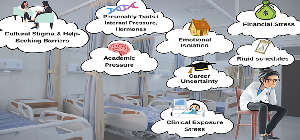Behind the White Coat: Burning Bright or Burning Out? An Observational Study
Authors
##plugins.themes.bootstrap3.article.main##
Abstract
Background: Depressive symptoms in medical students are a recent public health issue, and academic pressure, emotional exhaustion, and disturbances in lifestyle are very strong predisposing factors. Aim and Objective: To determine the trend and prevalence of depressive symptoms among undergraduate medical students by academic years, age, and gender using the PHQ-9 questionnaire. Methods: Cross-sectional observational study was conducted by using the PHQ-9 questionnaire. Information was collected from 100 students of 2nd, 4th, and final years. Age and gender profile was also noted. PHQ-9 (Patient Health Questionnaire-9) is a 9-item instrument to measure depressive symptoms during the past two weeks. Each item scored from 0 ("Not at all") to 3 ("Nearly every day"), with a total score ranging from 0 to 27. A higher score reflects more severity of depression. Results: Highest mean scores on PHQ-9 were among 5th-year students (females: 1.52, males: 1.46), reflecting a greater burden of depressive symptoms in final-year students. There was a statistically significant correlation between depression scores and academic year (Kruskal-Wallis H = 466.38, p < 0.0001), gender (Mann-Whitney U = 50863, p < 0.00001), and age (Spearman correlation = 0.41, p < 0.0001). The trend was graphically depicted with the violin, jitter and bubble plots. Fisher's Exact Test was applied for categorical comparisons. Conclusion: This study's findings provide that depressive symptoms are observed with greater frequency among final-year students and women. These findings emphasize the necessity of initiating early screening processes and psychological counselling for medical students. Longitudinal studies, proactive guidance, and organizational changes that address mental health requirements should be included in future interventions.
##plugins.themes.bootstrap3.article.details##
Copyright (c) 2025 Nair Deepa Balasubramanian, Gayathri V, Vijunath Thilakan, Jamila Hameed

This work is licensed under a Creative Commons Attribution 4.0 International License.
Creative Commons License All articles published in Annals of Medicine and Medical Sciences are licensed under a Creative Commons Attribution 4.0 International License.
[1] Fava M, Davidson KG. Definition and epidemiology of treatment-resistant depression. Psychiatric Clinics of North America. 1996 Jun 1;19(2):179-200.
[2] Mirza AA, Baig M, Beyari GM, Halawani MA, Mirza AA. Depression and anxiety among medical students: a brief overview. Advances in Medical Education and Practice. 2021 Apr 21:393-8.
[3] Guo Y, Li S, Zhang L, Xuan Q, He L, Ye Q, Ma J, Peng L, Xiong Y, Yang J, Yu H. Depression and anxiety of medical students at Kunming Medical University during COVID-19: a cross-sectional survey. Frontiers in Public Health. 2022 Sep 7; 10:957597.
[4] Stergiopoulos E, Fragoso L, Meeks LM. Cultural barriers to help-seeking in medical education. JAMA Internal Medicine. 2021 Feb 1;181(2):155-6.
[5] Kroenke K, Spitzer RL, Williams JB. The PHQ‐9: validity of a brief depression severity measure. Journal of general internal medicine. 2001 Sep;16(9):606-13.
[6] Rotenstein LS, Ramos MA, Torre M, Segal JB, Peluso MJ, Guille C, Sen S, Mata DA. Prevalence of depression, depressive symptoms, and suicidal ideation among medical students: a systematic review and meta-analysis. Jama. 2016 Dec 6;316(21):2214-36.
[7] Limone P, Toto GA. Factors that predispose undergraduates to mental issues: A cumulative literature review for future research perspectives. Frontiers in public health. 2022 Feb 16; 10:831349.
[8] Maqbool S, Sundus O, Khan MS, Ihtesham A, Mohamed WI, Maqbool RK, Sundus O, Khan MS, Ihtesham A, Mohamed WI, Khurshid R. Psychological factors related to professional examinations and their association with sleep quality among Medical students. Journal of Rawalpindi Medical College. 2021 Jul 15;25(1).
[9] Jafari N, Loghmani A, Montazeri A. Mental health of medical students in different levels of training. International journal of preventive medicine. 2012 Mar;3(Suppl1):S107.
[10] Jenkins TM, Kim J, Hu C, Hickernell JC, Watanaskul S, Yoon JD. Stressing the journey: using life stories to study medical student wellbeing. Advances in Health Sciences Education. 2018 Oct; 23:767-82.
[11] Hayes A, Hoover JN, Karunanayake CP, Uswak GS. Perceived causes of stress among a group of western Canadian dental students. BMC research notes. 2017 Dec; 10:1-9.
[12] Saravanan C, Wilks R. Medical students’ experience of and reaction to stress: the role of depression and anxiety. The scientific world journal. 2014;2014(1):737382.
[13] Thiemann P, Brimicombe J, Benson J, Quince T. When investigating depression and anxiety in undergraduate medical students timing of assessment is an important factor-a multicentre cross-sectional study. BMC medical education. 2020 Dec; 20:1-8.
[14] Malakcioglu C. Emotional loneliness, perceived stress, and academic burnout of medical students after the COVID-19 pandemic. Frontiers in Psychology. 2024 Jul 23; 15:1370845.
[15] Waqas A, Khan S, muhammad Sharif W, Ali A. Association of academic stressors with sleep disturbances in medical students: is psychological stress a mediator?. PeerJ PrePrints; 2014 Dec 16.
[16] Hardeman RR, Przedworski JM, Burke SE, Burgess DJ, Phelan SM, Dovidio JF, Nelson D, Rockwood T, van Ryn M. Mental well-being in first year medical students: a comparison by race and gender: a report from the medical student CHANGE study. Journal of racial and ethnic health disparities. 2015 Sep; 2:403-13.
[17] Satpathy P, Siddiqui N, Parida D, Sutar R. Prevalence of stress, stressors, and coping strategies among medical undergraduate students in a medical college of Mumbai. Journal of education and health promotion. 2021 Aug 31; 10:318.
[18] Hawsawi AA, Nixon N, Stewart E, Nixon E. Medical Students’ Perceptions of Factors Associated with Their Mental Health and Psychological Well-being. BJPsych Open. 2023;9(S1):S51–S51. doi:10.1192/bjo.2023.191
[19] Ngasa SN, Sama CB, Dzekem BS, Nforchu KN, Tindong M, Aroke D, Dimala CA. Prevalence and factors associated with depression among medical students in Cameroon: a cross-sectional study. BMC psychiatry. 2017 Dec; 17:1-7.
[20] Grace MK. Depressive symptoms, burnout, and declining medical career interest among undergraduate pre-medical students. International journal of medical education. 2018 Nov 26;9:302.
[21] Chandratre S. Medical students and COVID-19: challenges and supportive strategies. Journal of medical education and curricular development. 2020 Jun;7:2382120520935059.

